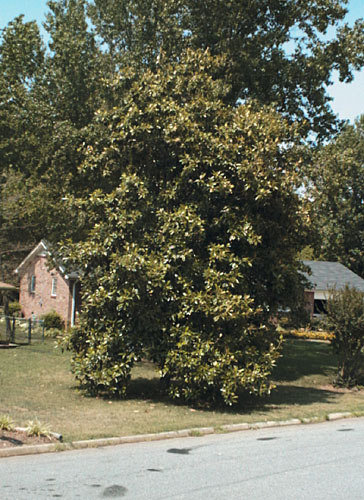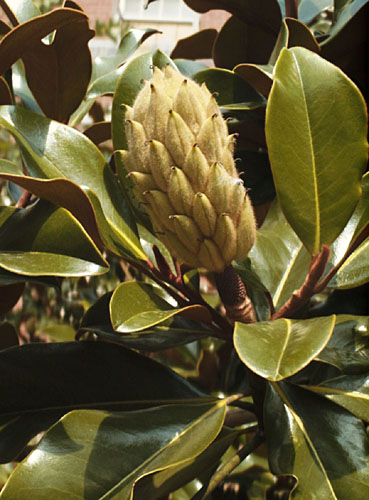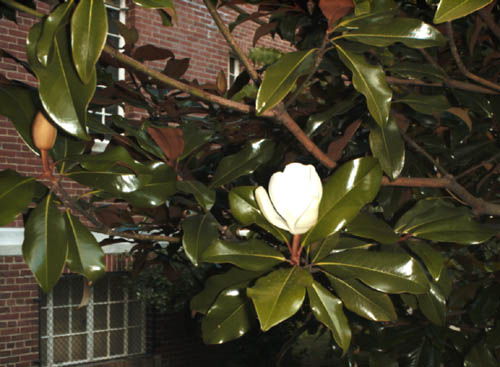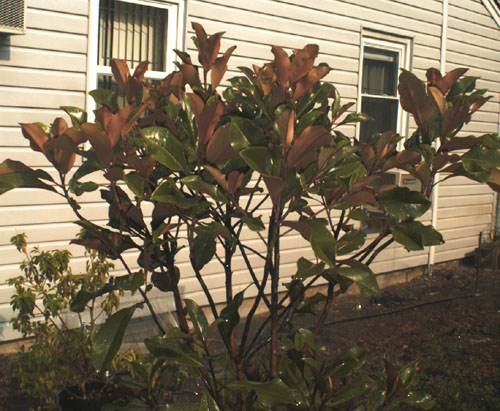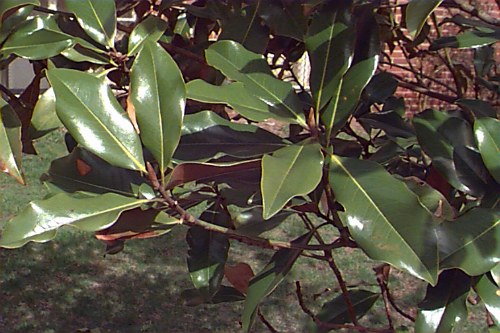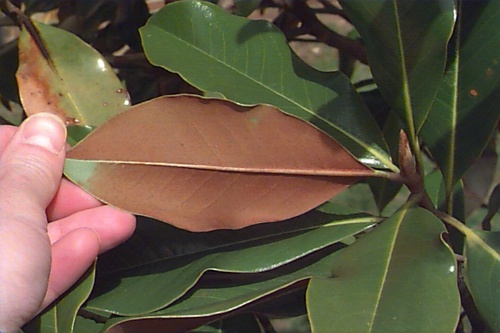Magnolia grandiflora
Southern Magnolia, Bull Bay
Magnoliaceae
ExpandHabitat
- native to North Carolina and across through Florida
- hardy to zone 6
Habit and Form
- a large evergreen tree
- pyramidal to oval growth habit
- low branching and dense
- 60' to 80' tall
- 30' to 50' wide
- coarse texture
- moderate growth rate
Summer Foliage
- alternate leaf arrangement
- simple, evergreen leaves
- elliptic leaf shape
- 5" to 10" long
- 2" to 5" wide
- entire leaf margins
- dense, brown pubescence on underside
- think and leathery
- leaf color is dark green
Autumn Foliage
- no fall color
Flowers
- white flowers
- blooms in spring and sporadically throughout season
- fragrant
- up to 12" in diameter
- saucer shaped
- found singly
Fruit
- elongated aggregate of follicles, 3" to 8" long
- red seeds
- showy
- persistent
- attracts birds
- matures in September
Bark
- smooth gray bark
- large scaly plates develop on mature trees
- stems are green and pubescent
- lenticels, small and gray-brown
- lemon scent when branch crushed or bruised
Culture
- full sun to shade
- soil tolerant
- transplant from container or B&B, difficult to transplant
- prune after flowering
- prefers rich, well-drained soil
- somewhat drought tolerant
Landscape Use
- espalier
- buffer
- screen
- for flowers and fruit
- for fragrance
- as a specimen
- shade tree
- street tree
- golf courses
- park tree
Liabilities
- leaves and fruit can be a litter problem
- can not tolerate soil compaction and rarely with survive in a construction site
- roots will girdle
- scale and aphids
- leaf spot
- thin bark, easily damaged by lawn equipment
- young trees don't flower
ID Features
- wooly, brown pubescence on terminal buds
- terminal buds are 0.75" to 1.25" long
- valvate, appressed and small lateral buds
- ash-gray, smooth bark
- emits citrus odor when branch bruised
- red seeds
- large, white flowers
Propagation
- by seed
- by tissue culture
- by budding and grafting
- by cuttings
Cultivars/Varieties
Many cultivars of this popular native evergreen tree exist, but the only cultivars described herein are those suitable for cultivation in southern New England.
'Bracken's Brown Beauty' (Bracken's Brown Beauty™) - Perhaps the hardiest cultivar and one of the most handsome, this plant has survived and thrived in a protected site at the University of Connecticut in Storrs, CT. It forms a very full, dense tree with wavy leaves that are lustrous green above and fuzzy brown underneath. The 6" wide blooms are white and result in reddish fruit. It seems to transplant easier than other forms and may reach 30' tall and wide in time. This selection is probably the cultivar best suited to cultivation in CT and MA.
'Edith Bogue' - Touted strongly in recent years as the most cold-hardy selection, this plant offers glossy deep green leaves that are light brown on the undersides. It reaches 30' tall and perhaps half as wide, with large white blooms. Though promoted more widely than 'Bracken's Brown Beauty', this plant has proved to be inferior in side-by-side observations. The foliage is of lower quality and the habit is more open.
